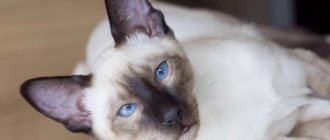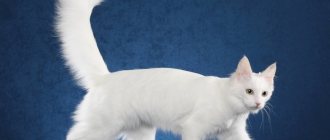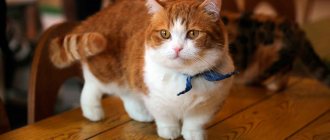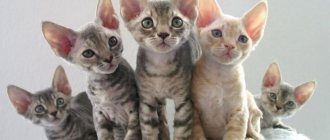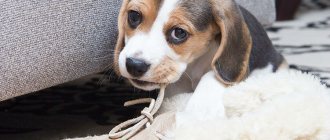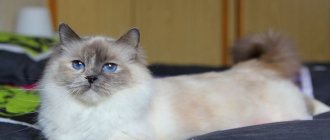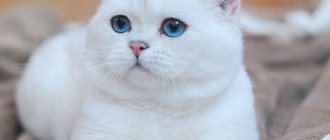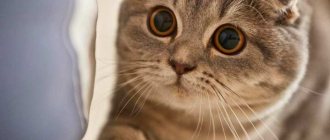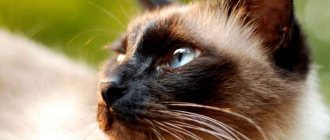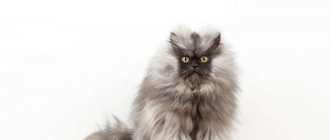This article will examine in more detail the history of the appearance of these unusual cats, a description of the breed and their characteristics, as well as the conditions of detention and information on where and how you can purchase these cats.
Origin story
The starting point in the development of the breed is considered to be 2005: it was then that the Osborne couple from Arkansas acquired an unusual-looking kitten: tiny, with short legs and a complete absence of hair on the body. The baby was named Bambino for his sweet appearance.
Time passed, the kitten grew, but remained the same miniature and short-legged. The couple realized that the matter was clearly a genetic mutation, and decided to try to establish a new breed.
Experimentally, it was possible to find out that the parents of the first bambino were munchkins and Canadian sphinxes. The work began to boil and already in 2005 the first “samples” began to appear at exhibitions. The breed received experimental status and geneticists were involved in the matter.
Many people condemn such crossing: it is believed that interspecific breeding is unsafe for the offspring, causing external deformities and genetic abnormalities. However, the bambino had so many fans that the social activists were unable to stop the work. They started breeding these cats in Russia, and at the same time. But, since they had no family ties with the Osborne pets, the breed line received its own special set of genes.
A bambino cat is expensive: a pet cat will cost about 90-100 thousand rubles, a breeding cat will cost over 200 thousand rubles. An elite cat will cost a cosmic sum. Also take into account upcoming expenses on food, cat cosmetics, etc.
Health
The breed is new, so not all the features of these cats have been identified yet. So far, breeders assure that bambinos do not have any congenital pathologies. With proper care, cats are predicted to live at least 12 years.
Tendency to diseases
If not properly cared for, bambinos can easily become infected with infectious diseases. The reason is the lack of wool, which is a natural barrier against drafts and cold air. The animal's skin has a special structure - folded, and has many sebaceous glands. If you do not clean it, inflammation and subsequent suppuration may occur.
Achondroplasia (the presence of short legs) does not affect health and life expectancy. But only if there is no dysplasia. A kitten can inherit this disease from its Munchkin ancestors, for whom impaired development of the hip joint is a typical pathology. Dysplasia can be recognized by unnaturally turned out hind legs and their weakness (they constantly turn in while walking, causing the animal to fall forward or to the side). An animal with diseased joints is susceptible to fractures and dislocations; Due to unstable paws, the load is incorrectly distributed and associated problems with the spine arise (for example, lordosis appears - curvature of the spinal column).
Defects of appearance that do not allow participation in exhibitions
A serious violation of the standard is the presence of long legs (exceeding 1/3 of the height at the withers), as well as hair growth of more than 2 mm (fluff on the ears and tail is allowed). A shortened body and a strong deflection in the spine when the cat is standing are also considered defects that do not allow participation in exhibitions. The display of aggression among bambinos is also not typical, so if a contestant rushes into a fight during an inspection by the commission, he will be disqualified.
Standards
Bambino cats are elegant and graceful creatures, although not without features that are unusual for the human eye. Outwardly, they resemble dachshunds: they are just as long, strong, with a rounded back and a belly as round as a ball. They weigh little: 2.5-4.5 kg. Females are visually smaller than males.
| Standard | Description |
| Head | Wedge-shaped, with a straight nose (the stop is barely visible) and prominent cheekbones (the pinch underneath is clearly visible). The whisker pads are dense, plump, the whiskers are broken, and the chin is clearly defined. The ears are large, wide at the base and rounded at the tips. The inside of the auricle is smooth, hairless, and covered with flock on the outside. |
| Eyes | They are shaped like a lemon, placed at a distance from each other and noticeably squinted. The iris can be anything, but a mandatory requirement is to match the color of the coat. |
| Torso | Elongated, with strong bones and a broad chest, chiseled shoulders and a massive neck. |
| Limbs | Short but strong, the front ones are visually longer than the front ones. The toes are long, graceful and very flexible. The pads are elastic and plump. The tail is of medium length with a tassel at the tip. |
| Wool | It may or may not be present (gummi type). The body feels like velor to the touch. |
The bambino's skin is very thick and wrinkled. The neck, muzzle, shoulder area and between the ears have the most folds.
Bambino in Russia
Finding a bambino kitten in Russia is very difficult. There are several nurseries that sell kittens. These are, as a rule, nurseries where breeders initially specialized in sphinxes, later including bambinos in the list of breeds.
Bambino kittens are quite difficult to find in Russia
If you want to purchase such a kitten, put special attention and effort into the search. Never send an advance payment if you found an advertisement for sale on an advertisement site. Nurseries have their own websites, and if you are not able to come pick up the kitten in person, the breeder will not refuse you a video conference to show the animal, its documents and answer all your questions. Today in Russia the following nurseries deal with bambino kittens:
- "Murmulet" (Moscow).
- "Lunabella" (Moscow region).
- "ShocoCats" (Moscow).
- "BoyJoy" (Yaroslavl) and the like.
Important point! Beware of scammers! Under the guise of a bambino, unscrupulous sellers may offer Sphynx kittens, which in childhood are practically indistinguishable from the described breed. The best way to look for a bambino kitten is by going to a cat show in your city. Most likely, you won’t find a kitten of this breed there, but you can talk to the breeders and try to get contact information for the right cattery.
Character and behavior
The character of the Bambino matches its name: cats of this breed are infinitely kind and devoted to their owners. They have no desire to hunt at all, therefore, no matter who lives in your house - a chattering parrot, a panting hedgehog, a restless hamster, another cat or dog - the bambino will quickly find a common language with him. Do not let your cat walk alone: he is in danger in the form of unfriendly animals. Bambino will not be able to repel an opponent even of his own size, so do not let your pet out of sight.
A smart and quick-witted bambino quickly learns all the rules of the house in which he lives. He runs to his litter box not only when he needs to, but also when he feels sick, so buy a container with low sides so that it is convenient for him to climb into it.
They love people and company, feel extremely uncomfortable alone and begin to break into closed doors with all their might. These are eternal children: they need constant attention, affection, lots of toys and control. Curious cats can jump from a height, stick their nose into a hot oven, try an electric wire on their teeth - in general, they have plenty of worries. Sometimes their attention is attracted by things that other cats are not interested in, so hide small and dangerous things away.
Feeding
Due to their high metabolic rate, bambino cats have a large appetite. Their sensitivity to cold necessitates a high-calorie diet to help regulate their temperature. They must have 24/7 access to food and clean water.
There are high-quality hairless cat foods available that are the best option. If you decide to keep your pet on a raw diet, organic meat may be the best option. Grinding the meat before feeding will help with digestion.
Care instructions
Bathing
These babies should be bathed regularly 2-3 times a week, or even more often (depending on the intensity of sebum secretion). When it accumulates on the skin, it causes an unpleasant odor, so when you bring home a new resident, immediately buy a special shampoo for cats. If your pet has a cold and cannot be bathed, use wet wipes (without alcohol or fragrance) to clean it.
To make the animal comfortable during the procedure, lay a thick diaper in the bath or place a rubberized mat. Then the cat will not slide its paws along the bottom. The water temperature is no higher and no lower than +23-25 degrees.
Ears
The ears are cleaned once a week using a cotton swab and chlorhexidine. Eyes - daily in the same way. Teeth – 2 times a month using cat toothpaste and a brush (you can also buy a children’s brush).
Claws
If a cat sharpens its claws on its own, it will not need your help. Otherwise, trim the claws once a week with a nail clipper, being careful not to damage the blood vessels or scratch the skin on the paw.
Do you trim your pet's nails?
Yes, he’s lazy with us. No, he sharpens himself.
Purchasing a kitten
Bambino is suitable for all animal lovers with a cheerful character. There is no need to be mistaken about the hypoallergenic nature of these cats. Some people have an intolerance to the protein Fel d 1, which is found in cat saliva and sweat, or Fel d 4, which is found in cat urine. Experts strongly recommend spending 1-2 hours in the company of these animals before purchasing. If in the process of communicating with a cat a skin rash, sneezing, or nasal congestion occurs, it means that it is better to cancel the purchase of a kitten of this breed.
Criterias of choice
You should not buy animals secondhand from unverified people. These are rare cats and, most likely, through private advertisements they will sell you a kitten that does not meet the breed standards. There are cases when scammers try to pass off a cheaper Sphynx or Minskin as a Bambino.
Some tips to help when buying a bambino:
- Buy bambino through nurseries where this breed is bred. In our country, such nurseries as “Murmlet”, “Ot Cotture”, “Marquise”, “Nika”, Cats & Company, “Favorit”, “Diamant Crystal”, “El Grand”, Baby Moon Cattery specialize in dwarf hairless cats.
- Be sure to study the baby's pedigree. Ask to see his parents (ideally they should both be bambinos, but it is possible for one parent to be a Sphynx - but this should reduce the cost of the kitten).
- Be sure to inspect the animal before purchasing. The main requirement is for the skin and paws. The first one should be smooth, without hair (except for the fluff on the ears and tail). Limbs no more than 1/3 of the length at the withers.
- The kitten should be cheerful and playful. Aggression is not typical for bambinos.
- Despite its short legs, the animal runs quickly and jumps to a small height. A cat should not limp or constantly fall over (this indicates pathologies of the limbs).
- When standing and walking, the kitten's back should be straight; strong bending or hunching in the lumbar region is not allowed.
When choosing a bambino, you need to look not only at short legs and lack of hair, but also at ensuring that the cat does not have strong arches in the back when standing
The age at which it is better to take a kitten from its mother
For the first two months of life, bambino babies are kept in isolation from the outside world, because due to their bald skin they are sensitive to temperature changes and can easily get hurt or catch a cold. It is better to take the animal from its mother after 3–4 months. Such kittens are already prepared for independent life - they know how to feed themselves, go to the toilet, and will not experience severe stress from being separated from their mother cat.
At 3–4 months, the kitten is no longer so attached to its mother, it can be taken home
Catering
Accelerated metabolism is another feature of bambino cats, but this also poses a danger, namely gluttony, which can lead to obesity and related problems. Therefore, do not react to your cat’s plaintive meowing and paw slap on an empty bowl: feed her exactly as much as required by her weight, and do not indulge her with snacks between main meals.
Keep bowls clean. They need to be washed after every meal and the water changed 2 times a day in the mornings and evenings.
Kittens up to 4 months eat 6 times a day, over six months - 3-4 times, over a year - at least 3 times.
At first, feed the baby the same thing that the breeder fed him, and introduce new food gradually. Whether you switch it to natural food from industrial food or vice versa - it doesn’t matter, the main thing is that the products must be of high quality, without chemical additives. What is suitable for humans is not suitable for animals, so remember a few nutritional rules.
Natural products
Bambino cats, like other cats, should not be fed from your table. Human food - fried potatoes, rolls, fatty soups, etc. - causes serious health problems in animals. But they don’t taste sweets at all, they can eat it with great appetite and become seriously poisoned in the future.
The basis of natural nutrition is lean meat, dairy products, cereals, vegetables and eggs. Meat (beef, veal, rabbit, turkey, lamb) should first be kept in the freezer for a couple of days, and scalded with boiling water or boiled before serving.
It is mixed with porridge cooked in water (oatmeal, rice, corn, buckwheat, millet or semolina), adding some vegetables (zucchini, pumpkin, carrots, beets, beans), fresh herbs (parsley, dill, green salad) and a spoon of any vegetable oil (sunflower, olive, flaxseed).
3-4 times a week the cat should be given dairy products: hard unsalted cheese, cottage cheese, yogurt, fermented baked milk, natural yogurt. From time to time, meat can be replaced with offal, stewed chicken hearts, liver, gizzards, ground into minced meat. The eggs are boiled and only the yolk is given from chicken eggs, whole quail eggs.
The following products should not be given:
- Salted (including pure salt), smoked, pickled, fatty;
- Condiments, sauces, spices, seasonings, aromatic herbs;
- Offal, lard, bones (including boiled chicken, especially dangerous);
- Potatoes, tomatoes, eggplants, fruits (exception: apples, pears, melons and watermelons);
- Human drinks;
- Dog food.
Recommended food
Economy class cat food: Wellkiss, TerraCot, 365 days.
Premium: Zoogurman, Mnyams, Native food.
Super premium: Pronature Life, Summit, Vet Life.
Holistic: Orijen, Power of Nature, Wildcat.
Below are recommended super-premium foods. Links with the names of the food are clickable, on them you can, within our website, read the descriptions of the food and read reviews from owners of Bambino cats.
| Premium | Super premium | Economy |
| Sirius | Leonardo | Perfect Fit |
The vitamin and mineral complex is selected taking into account the individual needs and parameters of the animal (age, weight, activity, concomitant diseases, etc.). Popular: “Agrovetzaschita”, “Farmaks”, “8 in 1”, “BEAPHAR”, “Doctor ZOO” can be bought at any veterinary pharmacy. In addition to vitamins, the cat should be given dry brewer's yeast in courses, according to the instructions.
How to raise a kitten
These cats are very active. Kittens are even more active. You need many different types of toys until you know what your cat likes. Climbing trees is one of their favorite activities. It is better to give them something suitable for climbing, otherwise they may find another interesting place that is less safe.
Bambinos are incredibly trainable. They like to do whatever is asked of them. While not geniuses, cats are smart enough to learn most commands. They are easy to train not to litter, and there are no problems learning to use a litter box or perform simple tasks.
Diseases
Bambinos are not long-livers: today, since the breed is still very young, the upper limit does not exceed 12 years. But everything can change: breeders are confident that if the breed is rid of hereditary problems, individuals will be able to live several years longer.
We managed to overcome the first problem, or rather, learn to cope with it with minimal losses. We are talking about hypertrophic cardiomyopathy - a pathology of the heart muscle that leads to the sudden death of a pet at a very young age. Most often, the disease occurs in males.
The animal becomes lethargic, refuses to play and does not want to run, it develops shortness of breath and coughing, fainting, and paralysis of the limbs. This pathology was inherited from the Canadian Sphynx and, unfortunately, it is impossible to cure it. But improving the quality of life with the help of drug therapy and regular medical supervision is quite possible.
The second problem also causes bambino owners a lot of trouble: weak immunity. Breeders especially recommend that owners not allow pets to come into contact with street animals, and also carefully plan the menu and ensure that the animal does not become hypothermic.
Expert opinion
Dusheba Vera Ivanovna
In 2010, she graduated from the Moscow State Academy of Veterinary Medicine named after K.I. Scriabin with honors, specializing in veterinary medicine. I regularly attend veterinary conferences, congresses, and webinars.
Many felinologists believe that the use of immunomodulators is not justified: they are expensive and do not have the desired effect. In any case, only a doctor should prescribe them.
Naturally, you should not refuse preventive vaccinations: against rabies, panleukopenia, calcivirosis, and the like. These diseases can lead to the death of your pet, and you can easily introduce pathogens into your home on your hands or the soles of your shoes. Please remember that you cannot:
- Use low-quality vaccines or expired vaccines;
- Vaccinate cats weakened after illness, exhausted, wormed (with the exception of extreme necessity), pregnant and lactating females, and babies;
- Individuals who have been in contact with suspicious and sick animals.
Vaccination against shingles is not mandatory, but is advisable if your cat lives in the same room as a dog.
Female bambinos successfully give birth and raise their offspring. Cats reach sexual maturity at 7-8 months, but it is better to introduce them to a cat within a year and a half. Usually no more than 4 kittens are born in a litter (every 4th embryo does not survive when mating such miniature individuals). If you do not plan to breed, have your cat spayed. “Empty” heats often lead to the formation of tumors.
Exceptional Features of the Bambino
Bambinos took most of their habits, as well as nuances in care, from their ancestor breeds. But the funny combination also has its own characteristics, which a person intending to own this breed should know about.
The first feature concerns the fact that not all bambino kittens are born as the standard prescribes. The litter may produce kittens with normal leg lengths, which in fact do not differ from the classic Canadian Sphynx. Formally, these kittens are representatives of the bambino breed, but outwardly they are not. In this feature lies the second - it is extremely difficult to buy an unsterilized kitten.
Kittens from the same litter
Due to the experimental nature of the breed and the importance of knowledge about bambino breeding, breeders do not sell breeding kittens just like that. If a person wants to have a pet, and is not a specialist in the field of breeding cats, they can only offer him a castrated/sterilized animal, that is, without the right to breed. This approach is justified, first of all, by concern for the safety of the breed and the health of specific individuals. If the owner of a bambino wants to cross it with another breed, the mutation in the genes can be unpredictable.
Another curious feature of bambinos is their favorite pose. Cats often sit on their hind legs, stretched out in a column, like gophers. Perhaps this is due to their short stature and desire to see more space, perhaps with the physiological nuances of their body structure. In any case, a kitten standing on its hind legs causes tenderness to everyone around!
Let's sum it up
Bambinos are charming cats with an alien appearance. Yes, not everyone likes this breed, but lovers of hairless cats have long appreciated the beauty of short-legged Sphynxes. To become the owner of this exotic and rare feline, you need to be prepared to spend a lot of money - a bambino kitten is not cheap, and finding a bona fide breeder is not easy. But, if you set a goal, you can become the owner of an incredibly affectionate, beautiful and unusual animal that will become a real member of the family.
Bambino kitten price
The most significant disadvantage of the breed is its cost. The price for bambino kittens starts from 50 thousand rubles, the average cost in Russia is 80-90 thousand rubles, and for this amount, most likely, they will sell you an animal without the right to breed. Breeding bambinos can cost up to 350 thousand rubles.
Due to the fact that the breed is rare, to this amount you need to add the cost of traveling to another city to pick up the kitten or the cost of delivery, which is paid by the owner. Thus, the cost of purchasing a bambino, as well as purchasing accessories necessary for the animal (care cosmetics, food, vitamins, a bed-house) will be quite considerable.
Video - Bambino: the most extraordinary cat
Hairless cats - top 10 breeds
To understand how hairless cats of different breeds differ, what they are called and what they look like, it is worth clarifying that their breeds have different origins. Some of them appeared naturally, through spontaneous mutation: these are the Don and Canadian sphinxes, and the Cojona. The rest of the hairless four-legged felines were bred by selection methods, that is, artificially.
There are currently nine breeds of hairless cats recorded in the world, and three of them were obtained naturally: the Canadian and Don Sphynx and the Cojona. Let's look at their characteristic features along with the photo:
Canadian Sphynx
Canadian Sphynx
They have a graceful but athletic body, a wide chest and a whip-like tail. The Canadian breed standard includes a small tuft at the tip of the tail. The wedge-shaped head and wide-set ears are a distinctive feature of the breed. Some individuals may have fluff that is almost invisible to the eye. They are very gentle, loyal animals, easy to socialize and have a lively temperament.
Don Sphynx kitten
Don Sphynx
The first cat of this breed appeared by chance in Rostov-on-Don in 1987. Later she gave birth to bald offspring, giving rise to a new branch of the breed. Don Sphynxes are similar to Canadian ones, but are distinguished by a more independent and wayward character. Juveniles sometimes exhibit a small amount of soft down on the body, which disappears by the age of two years.
Hawaiian hairless cat (cohona)
Kohona (Hawaiian cat)
As the name suggests, originally from the Hawaiian Islands, the cat is completely hairless due to the complete absence of hair follicles. A rare breed of cat that is found mainly on the North American continent; there are about a hundred adult individuals in the world. The skin looks like rubber or wax, completely smooth.
With the help of breeding programs of felinologists, the following breeds of hairless cats were obtained:
Petersburg Sphynx Peterbald
Peterbald
The breed, bred in St. Petersburg, was officially registered in 1996. A felinologist crossed the Don Sphynx with an Oriental cat, and both of these breeds can be seen in the Peterbald’s exterior. A narrow muzzle with folds at the base, slanted eyes and large ears; thin, long, necessarily bald tail, graceful elongated body. The skin is covered with fluff, reminiscent of thin suede.
Bambino
Bambino
Translated from Italian as “child” or “baby,” this is the name given to the breed by the couple who bred these cats from the Canadian Sphynx and Munchkin. This breed is characterized by a long body and short legs, weighing no more than 2.5 kg. The round muzzle with large eyes resembles a child's expression. Large ears taper to the tips, furless skin is covered with folds.
Ukrainian Levkoy
Ukrainian Levkoy
Descendants of the Don Sphynx and Scottish Fold, bred in 2004 in Kyiv. The peculiarity of these hairless cats is their curved ears, reminiscent of the petals of a gillyflower. The exterior is also characterized by a five-sided wedge-shaped head, wide-set ears, between which there are wrinkles on the almost flat forehead.
Elf kitten
Elf
Elves were bred in the USA in 2006 and are descended from the American Curl and Dwelf with the addition of the Munchkin gene. Unusual even for hairless breeds, elves are distinguished by their wide-set, small, backward-turned ears, which give this breed a resemblance to the magical creatures of the same name. These are cats with a muscular body on long graceful legs and a wedge-shaped head.
Minskin
Minskin
Felinologists set themselves the goal of creating a cat with short legs, soft hair, located in place of the dark spots of Siamese cats, and the rest of the skin, like that of Sphynxes. They crossed a munchkin with short legs and a sphinx to obtain a hairless trait, using the gene from the Devon Rex and the Burmese. The result of the work was agile short-legged cats with a wide head and short muzzle, large eyes and ears. The long body is covered with short hair with fur points on the ears, muzzle, paws, tail and under the tail, the belly is always hairless.
Dwelf
Dwelf
The appearance of cats of this breed contains the features of its three ancestors: the Sphynx, the Munchkin and the American Curl. This is a small cat, the weight of an adult rarely reaches two kg. The peculiarity of the Dwelf is its short legs, backward-curved ears on a wedge-shaped head and large almond-shaped eyes. The body may be covered with light fluff either completely or in individual parts, for example, the edges of the ears or paws.
Proper pet maintenance
The Bambino breed requires attention and needs active communication with humans. Owners will have to constantly care for their cat's skin and ensure that the environment in the home suits their pet's needs.
Nutrition
The lack of fur and greater mobility of cats affect accelerated metabolism - this is a natural feature that ensures better heat exchange. The active metabolism of pets obliges owners to select high-calorie foods and increase the daily number of meals.
Quantity and composition of food
In food preferences, bambinos are similar to their “ancestors”, sphinxes. They are quite picky about food and do not have congenital intolerance to certain foods. You can give them dry food or make various dishes yourself. In the first case, you should choose canvas food (in which the meat content exceeds 50%). If the owner himself wants to cook for the cat, then he will have to follow the rules:
- Cats need meat every day. Preference should be given to turkey and rabbit.
- Give by-products - chicken or turkey liver, kidneys, hearts - 1-2 times a week.
- Mix the meat with peas, lentils, sweet potatoes, brown and white rice.
- 3-4 times a week feed the cat grated carrots, pumpkin pulp, boiled cabbage, and zucchini.
- Once every 7 days, treat them to a boiled chicken or quail egg.
The size of a single serving of food is calculated using the formula: 40 g of natural food per 1 kg of body weight, but the total daily volume should not exceed 250 g. The dosage of dry food is determined at the rate of 15–20 g of croquettes per 1 kg of cat weight.
How many times a day should you feed your pet?
Kittens under 2 months of age require 6 feedings a day. Until six months of age, they should be fed 4 times a day. From 9 months - 2-3 times.
The role of a balanced diet
The ratio of proteins, fats and carbohydrates in a bambino's daily diet should approach the proportion of 56–34–10%. For the normal functioning of internal organs, vitamins are required. Vitamins A, C, B, D, E, H (biotin) are important for dwarf hairless cats. Since their short legs receive a lot of stress, bones and joints need to be strengthened with the help of dietary supplements containing calcium and glucosamine.
Bambino grooming
The absence of hair eliminates the need to comb the animal. But this does not mean that the cat does not require care. You will have to monitor your pet’s appearance a little more than an ordinary long-haired cat. But you shouldn’t panic - the measures are quite simple and do not require special training.
Bathing
Bambinos should be washed at least once a month. You should not rub your cat's skin with hard brushes, as this will cause pain to your pet. You can use a soft sponge or apply shampoo by hand. Use only those products that are suitable for caring for hairless cats - for example, “Graceful Sphinx” (Ms. Kiss) or “Care and moisturizing for hairless animals” (Royal Groom).
Hairless cats should be washed with special shampoos
When bathing, it is important to monitor the water temperature so that the animal does not freeze. After washing, pat the animal's skin dry with a soft towel and dry the ears thoroughly.
Additional tips for caring for your cat's appearance
If you need to bathe a bambino only once a month, then you will have to wipe its skin daily. This procedure is necessary to eliminate traces of sebum and impurities that lead to inflammation. For the cleaning procedure, you need to use a fragrance-free lotion for sensitive skin. The product is applied to a cotton pad or hypoallergenic napkin.
Once a week you will have to clean your ears. In bambinos they are large and do not have protective fibers, so they quickly become dirty. The procedure is done as follows: apply a special product (for example, Veteritsin) to a cloth and treat the auricle with light circular movements.
Other Content Features
The main condition for caring for a hairless cat is to constantly monitor the temperature in the house. If your bambino is cold all the time and is shivering, you can use pet clothes. Soft vests made from materials that do not irritate the delicate skin of the cat are suitable. As for the selection of a tray, bowl, sleeping place - there are no special features here. The same rules apply as for cats of other breeds.
Breeding
Breeding bambinos is not an easy task. It is better to do this in a nursery than in an apartment on an amateur basis. A cat rarely brings more than four babies, since every fourth embryo when crossing dwarf individuals is usually not viable.
Some newborn kittens will have long legs. They are well suited for crossing as they increase the likelihood of producing healthy offspring. Breeding with other breeds is not recommended. To prevent outside breeding, many breeders offering elves and bambinos neuter bambino kittens before sale at 4 months of age.
Allergy
Bambino is an ideal solution for those who have family members who are allergic to cat hair. Such a cat either has no hair or has small hairs that do not affect the allergy receptors.
In rare cases, irritant reactions may occur to the protein secreted by the breed, which is produced on the surface of the skin by sweat glands or during urination.
If you don't pay enough attention to caring for your cat's skin, it may begin to peel off, which will stimulate the receptors, causing sneezing and itching on the skin and eyes, especially if the person in contact has an allergy to dust.
Cat fluff and hair cause allergies
It’s easy to find out whether a bambino will cause allergies: just spend about two hours communicating with it.
Interesting Facts
The unusual appearance and habit of freezing in a standing position gave bambino funny nicknames: kangaroos, monkeys, dachshund cat, gnome, dwelf. They jump in height weakly and cannot climb onto a cabinet or refrigerator like other cats. Be sure to provide stepped lifts to ensure vertical movement and prevent health problems.
Some felinologists recognize the bambino as a hybrid, and not a separate breed. Therefore they are not kept in Germany. They look awkward, but have excellent control over their atypical body. They retain a playful disposition for a long time; restraint appears by the age of three.
An interesting alternative to the bambino is the elf, a cross between the American Curl and the Canadian Sphynx. The pet has an easy-going character and a cute curl on its ears. Catteries specializing in breeding hairless cats offer elves and bambinos of unusual colors, providing them with decent care.
